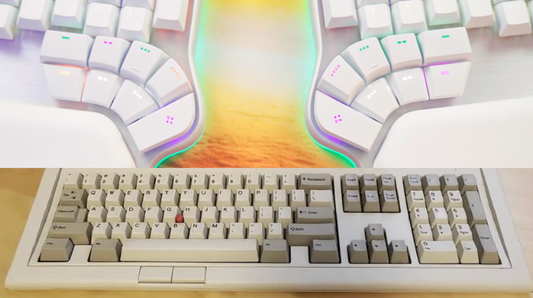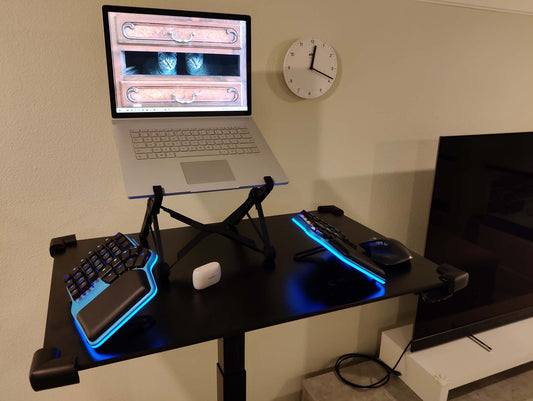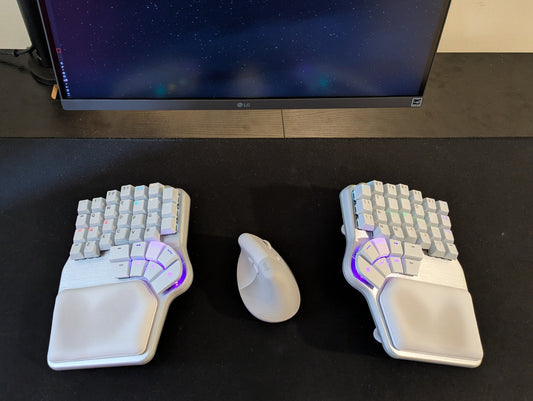We all want a keyboard that sounds nice, but what “nice” means can vary a lot from person to person.
You’ve probably heard people describe their keyboard sound as creamy, thoccy, poppy, crispy, muted, or snappy.
That sound is mostly determined by the switches and the keyboard’s construction, but keycaps play a much bigger role than most people think.
So to find out exactly how big that role is, we’ve gone a bit crazy. We’ve tested keycaps of all shapes and materials to see how they impact the sound of the same keyboard.
What affects the sound of keycaps?
When you press a key, keycaps act as acoustic resonators. Their material, thickness, and shape determine the frequencies that are amplified or absorbed. In other words, whether your keyboard sounds thocky, clacky, or muted.

How keycap materials affect sound
PBT has a density of about 1.3 g/cm³, and its porous structure provides good internal damping for higher frequencies. That gives you a lower, thoccier sound compared to ABS or PC.

ABS and polycarbonate (PC) are lighter (around 1.0 to 1.2 g/cm³) and far less porous, which produces a higher-pitched, more clacky tone.

Then there’s POM, denser than PBT at 1.4 g/cm³. It has a smooth surface and decent damping, creating a muted but crisp tone often described as buttery.

Ceramic keycaps are in a league of their own: almost 4 g/cm³ and extremely rigid. That translates to a lower-pitched, louder sound with a sharper attack and very little reverb. People describe it as marbly , dense and solid , sometimes with a subtle, bell-like after-tone, like when two porcelain cups touch.

And finally, rubber keycaps. Their soft surface absorbs high frequencies, making the keyboard much quieter and more muted overall.

However, be careful with rubber keycaps; some of them are PBT keycaps with a rubber coating. Those won't sound as you expect.

How wall thickness affects sound

Now, let’s talk about wall thickness, one of the most underrated factors in keyboard acoustics.
The thicker the wall, the stiffer and heavier the keycap becomes, which affects two main things:
- Resonant frequency: thicker caps resonate at lower frequencies, giving a deeper “thock.”
- Damping: more mass absorbs more highs, resulting in a rounder, less plasticky tone.
If you’ve ever tapped a thin plastic cup versus a ceramic mug, that’s exactly the difference.
Laser-etched ABS or PC keycaps are usually thinner, around 1.0 to 1.2 mm, producing a bright, clacky sound.
Double-shot or dye-sub PBT keycaps range from 1.1 to 1.8 mm, and even a few tenths of a millimeter can make a big difference.
The thicker the wall, the deeper and fuller the sound.

How the Keycap Profile affects sound
Finally, there’s the shape or profile of the keycap.
Taller profiles, such as SA, ASA, or Tai-Hao’s Bobo, have a larger internal cavity, creating a lower-pitched sound with a longer resonance. You could call it a bassy thock.

Medium-height profiles, such as OEM or Cherry, produce a balanced tone with a short decay. Poppy, clean, maybe a bit crisp for Cherry.

Uniform low profiles like DSA or XDA have smaller cavities, resulting in a higher-pitched, clackier tone.

And low-profile keycaps have almost no cavity at all, so the sound is immediate, bright, and sharp.

If you listen closely, you can even hear pitch differences between rows on sculpted profiles. Upper rows have larger cavities and sound slightly deeper.
And if we get really technical, a spherical, cylindrical, or flat keycap top will reflect and scatter sound waves a bit differently. But honestly, we dare you to notice that.

Ultimately, it’s the combination of material, wall thickness, and profile that gives each keycap its unique acoustic signature.
But remember: keycaps are only one part of the equation. Switches and keyboard construction shape the overall tone just as much.
If you want your keyboard to sound a certain way, you need to align all three of them. Otherwise, your keyboard will sound like a guitar that hasn’t been tuned.









